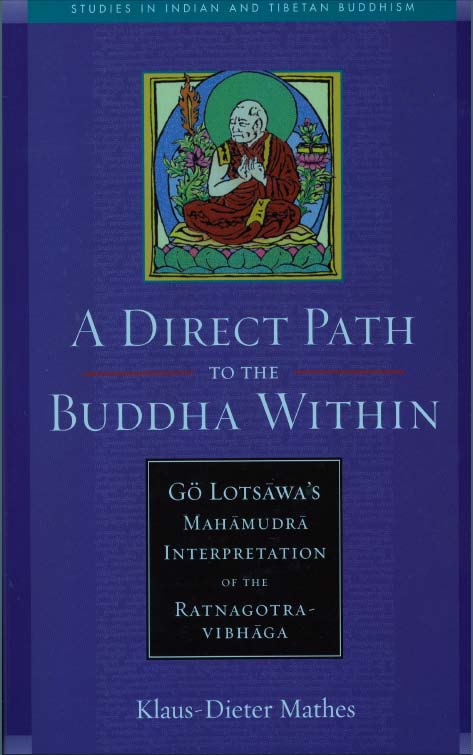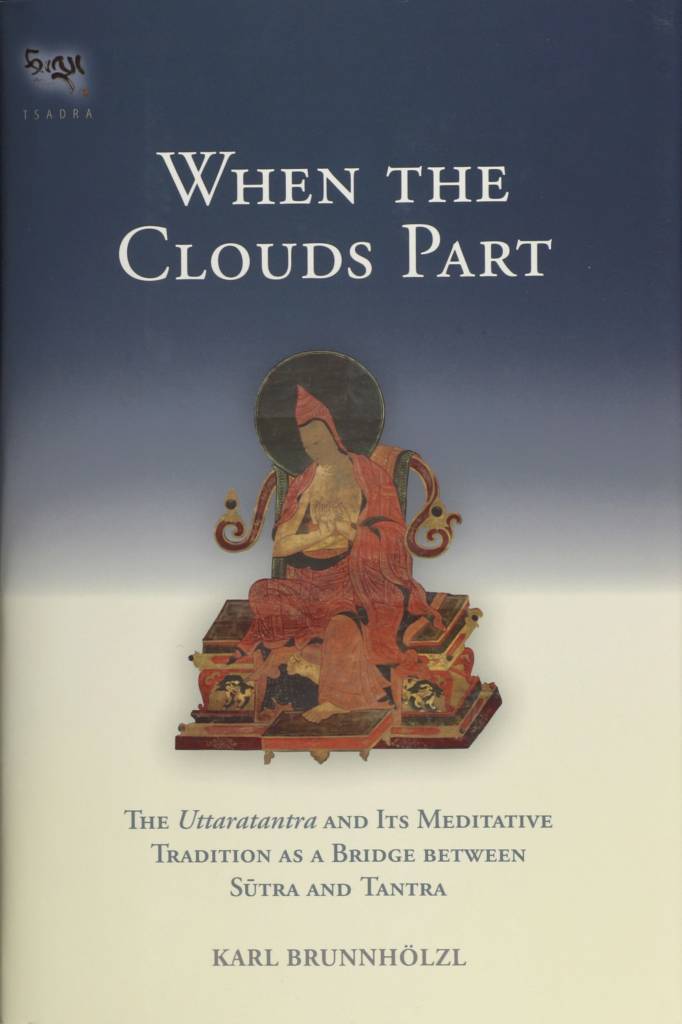Mahāmudrā and Buddha-Nature
Watch & Learn
In English with his direct, characteristic humor, Khenpo Rinpoche presents the "shining star" of buddha-nature in the minds of sentient beings as the same nature as the buddhas. He says, "We are always guided by this nature all the time whether we realize it or not."
From the Masters
Gampopa
As told by Gö Lotsāwa Zhönu Pal:
- དེ་ཡང་དྭགས་པོ་རིན་པོ་ཆེས་དཔལ་ཕག་མོ་གྲུ་པ་ལ། འོ་སྐོལ་གྱི་ཕྱག་རྒྱ་ཆེན་པོ་འདིའི་གཞུང་ནི་བཅོམ་ལྡན་འདས་བྱམས་པས་མཛད་པའི་ཐེག་པ་ཆེན་པོ་རྒྱུད་བླ་མའི་བསྟན་བཅོས་འདི་ཡིན་ཞེས་གསུངས་ཤིང་། དཔལ་ཕག་མོ་གྲུ་པས་ཀྱང་རྗེ་འབྲི་ཁུང་པ་ལ་དེ་སྐད་དུ་གསུངས་པས། རྗེ་འབྲི་ཁུང་པ་དཔོན་སློབ་ཀྱི་གསུང་རབ་རྣམས་སུ་ཐེག་པ་ཆེན་པོ་རྒྱུད་བླ་མའི་བཤད་པ་མང་དུ་འབྱུང་བ་དེ་ཡིན་ནོ།
- Moreover, Dagpo Rinpoché (Gampopa) said to Pagmo Drupa:
"The basic text of this mahāmudrā of ours is the Mahāyānottaratantraśāstra (Ratnagotravibhāga) by Venerable Maitreya." Pagmo Drupa in turn said the same thing to Jé Drigungpa (Rje 'Bri gung pa), and for this reason many explanations of the Mahāyānottaratantraśāstra are found in the works of Jé Drigungpa and his disciples.~ 'gos lo tsA ba gzhon nu dpal. Deb ther sngon po. Chengdu: Si khron mi rigs dpe skrun khang, 1984: Vol. 2, p. 847.
-Translation from Mathes, Klaus-Dieter. A Direct Path to the Buddha Within: Go Lotsāwa's Mahāmudrā Interpretation of the Ratnagotravibhāga. Studies in Indian and Tibetan Buddhism. Boston: Wisdom Publications, 2008: pp. 34-35.
As quoted by Śākya Chokden:
- དེ་ཡང་སྒམ་པོ་པས་གསུངས་པ། ང་ཡི་ཕྱག་རྒྱ་ཆེན་པོ་ཡི། ངོས་འཛིན་རང་གི་རིག་པ་སྟེ། གཞུང་ནི་རྒྱུད་བླའི་བསྟན་བཅོས་ཞེས།
- In that regard Gampopa says, “the hallmark of my Mahāmudrā is self-awareness and its scriptural source is the Uttaratantraśāstra”.
~ shAkya mchog ldan. gzhan blo’i dregs pa nyams byed in gsung 'bum. (Sachen International: Kathmandu, 2006), Vol. 17: p. 364.
-Translation adapted from Higgins, David and Martina Draszczyk. Mahāmudrā and the Middle Way: Post-Classical Kagyü Discourses on Mind, Emptiness and Buddha-Nature. Vienna: Arbeitskreis für Tibetische und Buddhistische Studien Universität Wien, 2016: Vol. 2, p. 17.
Third Karmapa Rangjung Dorje
In his The Treatise on Pointing Out the Tathāgata Heart, the Third Karmapa states:
- །ཐ་མལ་ཤེས་པ་དེ་ཉིད་ལ།
།ཆོས་དབྱིངས་རྒྱལ་བའི་སྙིང་པོ་ཟེར།
།བཟང་དུ་འཕགས་པས་བཏང་བ་མེད།
།ངན་དུ་སེམས་ཅན་གྱིས་མ་བཏང་།
།ཐ་སྙད་དུ་མ་བརྗོད་མོད་ཀྱང།
།རྗོད་པས་དེ་ཡི་དོན་མི་ཤེས།- Just this ordinary mind
Is called "dharmadhātu" and "Heart of the victors."
It is neither to be improved by the noble ones
Nor made worse by sentient beings.
It may no doubt be expressed through many conventional terms,
But its actual reality is not understood through expressions.~ rang byung rdo rje, (Karmapa, 3rd). de bzhin gshegs pa'i snying po bstan pa'i bstan bcos. In gsung 'bum rang byung rdo rje. Zi ling: mtshur phu mkhan po lo yag bkra shis, 2006: Vol. 7, p. 285.
-Karmapa, The Third, Rang byung rdo rje. Luminous Heart: The Third Karmapa on Consciousness, Wisdom, and Buddha Nature. Translated by Karl Brunnhölzl. Nitartha Institute Series. Ithaca, NY: Snow Lion Publications, 2009: pp. 354-355.
In Jamgön Kongtrul's Treasury of Knowledge he references the Third Karmapa, claiming:
- Venerable Rangjung [Dorje] states:
- The basic nature free from reference points, Mahāmudrā,
- Is empty of all characteristics of the reference points of thoughts.
- This pure nature, lucid and yet without grasping,
- Is also called "the tathāgata heart."
~ Brunnhölzl, Karl. When the Clouds Part: The Uttaratantra and its Meditative Tradition as a Bridge between Sūtra and Tantra. Boston: Snow Lion Publications, an imprint of Shambhala Publications, 2015: p. 154.
Dakpo Tashi Namgyal
To summarize, the teachings in the sūtras and tantras on the ground abiding state- such as that of tathāgatagarbha [buddha nature] abides primordially in the mindstreams of sentient beings and that the nature of mind is luminosity- are presentations of ground mahāmudrā. Teachings on the development of the dhātu of [tathāgata]garbha, on freedom from elaborations, instances of emptiness, the unreality of phenomena, their absence of a self-entity, their equality, and their unification are all considered path mahāmudrā. Teachings on the awakening of the wisdom of complete omniscience (such as the four kāyas and five wisdoms) are presentations of fruition mahāmudrā.~ Callahan, Elizabeth M., Moonbeams of Mahāmudrā - Dakpo Tashi Namgyal: With Dispelling the Darkness of Ignorance by Wangchuk Dorje, the Ninth Karmapa. Boulder: Snow Lion Publications, 2019: p. 121.
Tsele Natsok Rangdrol
On the correlation of various terms Tsele Natsok Rangdrol states:
- །རང་བྱུང་རང་ཤར་རང་རིག་ཆོས་ཉིད་དོན། །འདི་ལ་མིང་གི་རྣམ་གྲངས་སྣ་ཚོགས་ཏེ། །ཕར་ཕྱིན་ཐེག་པར་ཆོས་ཉིད་བདེན་པ་ཟེར། །སྔགས་ཀྱི་ཐེག་པ་རང་བཞིན་འོད་གསལ་ཟེར། །སེམས་ཅན་དུས་ན་བདེར་གཤེགས་སྙིང་པོའི་ཁམས། །ལམ་གྱི་སྐབས་སུ་ལྟ་སྒོམ་ལ་སོགས་མིང། །འབྲས་བུའི་དུས་ན་སངས་རྒྱས་ཆོས་སྐུ་ཟེར། །དེ་སོགས་མིནད་དང་དབྱེ་བ་དུ་མ་ཡང་། །དོན་ལ་ད་ལྟའི་ཐ་མལ་ཤེས་པ་འདིའོ།
- This self-existing and self-manifest natural awareness, your basic state,
Has a variety of names:
In the Prajnaparamita vehicle it is called innate truth.
The vehicle of Mantra calls it natural luminosity.
While a sentient being it is named sugata-garbha.
During the path it is given names which describe the view, meditation, and so forth.
And at the point of fruition it is named the dharmakaya of buddhahood.
All the different names and classifications
Are nothing other than this present ordinary mind.~ rtse le sna tshogs rang grol. nges don gyi lta sgom nyams su len tshul ji lta bar ston pa rdo rje'i mdo 'dzin. In rtse le sna tshogs rang grol gyi gsung gdams zab phyogs bsgrigs. Kathmandu: Khenpo Shedup tenzin and Lama Thinley namgyal, 2007: pp.13-14.
-Tsele Natsok Rangdrol. The Heart of the Matter: The Unchanging Convergence of Vital that Show Exactly How to Apply the View and Meditation of the Definitive Meaning. Translated by Erik Pema Kunsang. Kathmandu: Rangjung Yeshe Publications, 2002: p. 14.
As for the cognizant quality or wisdom aspect of this self-luminous consciousness, its essence is empty, its nature is cognizant, and these two are inseparable as the core of awareness. Being the seed or cause of all the buddha qualities and attributes of the pure paths, this is also known as the "true all-ground of application," "sugata-essence," "dharmakaya of self-cognizance," "transcendent knowledge," "buddha of your own mind," and so forth. All of these names given to the classifications of nirvanic attributes are synonymous. This wisdom aspect is exactly what should be realized and recognized by everyone who has entered the path.~ Tsele Natsok Rangdrol. Lamp of Mahamudra: the immaculate lamp, that perfectly and fully illuminates, the meaning of Mahamudra, the essence of all phenomena. Translated by Erik Pema Kunsang. Boston: Shambhala Publications, 1989: pp. 6-7.
Khenpo Gangshar
In his Naturally Liberating Whatever You Meet: Instructions to Guide You on the Profound Path, Khenpo Gangshar states:
- འདི་སེམས་ཅན་ཐམས་ཅད་ཀྱི་སེམས་ཀྱི་རང་བཞིན། དུས་གསུམ་སངས་རྒྱས་ཀྱི་དགོངས་པ། ཆོས་སྒོ་བརྒྱད་ཁྲི་བཞི་སྟོང་གི་སྙིང་པོ། འདྲེན་མཆོག་དཔལ་ལྡན་བླ་མའི་ཐུགས། བཀའ་བར་པ་ནས་ཤེར་ཕྱིན་དང་འཁོར་ལོ་ཐ་མ་ནས་བདེ་གཤེགས་སྙིང་པོ། སྔགས་ཐུན་མོང་བའི་སྐབས་སུ། གཞི་རྒྱུད་རང་བཞིན་ལྷུན་གྱིས་གྲུབ་པའི་དཀྱིལ་འཁོར་
- The mind-essence is the nature of all sentient beings, the realization of the buddhas of the three times, the essence of the eighty-four thousand Dharma-doors and the heart of the glorious master, the supreme guide. It is the transcendent knowledge of the second set of teachings and the sugata-essence of the last turning of the wheel of the Dharma. According to the general system of mantra it is called continuity of ground, the spontaneously present mandala of the innate nature.
~ Mkhan po gang shar. zab lam khrid kyi man ngag 'phrad tshad rang grol. In gsung 'bum gang shar dbang po. Kathmandu: thrangu tashi choling, 2008: p. 121.
-Translation from Thrangu Rinpoche. Vivid Awareness: The Mind Instructions of Khenpo Gangshar. Translated by David Karma Choephel. Boston: Shambhala Publications, 2011: p. 226.
Thrangu Rinpoche
The Kagyu masters of the past as an instruction called this the ordinary mind, or the natural state. They called it this out of their experience. This ordinary mind itself is the dharma expanse and the essence of the buddhas: it is our buddha nature. This is exactly what the term means; this is what we need to experience and recognize.~ Thrangu Rinpoche. Vivid Awareness: The Mind Instructions of Khenpo Gangshar. Translated by David Karma Choephel. Boston: Shambhala Publications, 2011: p. 124.
Further Readings
[A Direct Path to the Buddha Within]
One of the main goals of Zhönu Pal's Ratnagotravibhāga commentary is to show that the Kagyü path of mahāmudrā is already taught in the Maitreya works and the Laṅkāvatārasūtra. This approach involves resting your mind in a nonconceptual experience of luminosity or the dharmadhātu (the expanse or nature of all phenomena) with the help of special "pith instructions" (Tib. man ngag) on how to become mentally disengaged. A path of directly realizing buddha nature is thus distinguished from a Madhyamaka path of logical inference and it is with this in mind that Zhönu Pal's commentary can be called a "direct path to the buddha within."
[When the Clouds Part]
As stated before, texts such as CMW, those by Mönlam Tsültrim, GC, the Eighth Karmapa’s Lamp, and GISM all establish connections between the Uttaratantra and Mahāmudrā. Such connections are also found in a number of Indian and Tibetan Mahāmudrā works. Usually, these connections are made in the wider context of the Mahāmudrā approaches that came to be called "sūtra Mahāmudrā" or "essence Mahāmudrā" (the Mahāmudrā approach that is beyond "sūtra Mahāmudrā" and "tantra Mahāmudrā"). In order to provide some background against which the Uttaratantra-based Mahāmudrā instructions in the above texts can be appreciated more fully, I will next present an overview of the key elements of the different approaches to Mahāmudrā, their origins, their scriptural sources, and the different ways in which they are taught.


